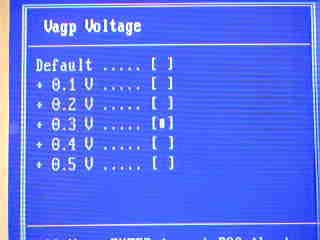EPoX EP-8KTA3 Socket-A KT133A ATX
by Mike Andrawes on January 25, 2001 4:48 PM EST- Posted in
- Motherboards
EPoX is Unique as well
Besides the flexible four DIMM slots implementation, the HSF unit on the North Bridge for better cooling, and the expansion slot design, EPoX has also done many other things to make the EP-8KTA3 a more unique motherboard and a better contender in the KT133A market.
One of the biggest achievements by EPoX is the migration from dipswitches to BIOS implementation for voltages and multiplier ratios. With the old EP-8KTA2, in order to modify the multiplier ratios or the CPU core voltage, you would have to turn off your machine, modify the dipswitch settings, and boot up your machine to accept the new settings.
With the new EP-8KTA3, everything is in the BIOS. Under the “Frequency/Voltage Setting” panel, users are able to find all the necessary settings. Provided that you have your AMD CPU unlocked already, you can easily adjust the multiplier ratio from 5.5 to 12.5.

Yes, multiplier settings are in the BIOS now!
For FSB speed setting, EPoX does not have the detail 1MHz increments like the SoftMenu III by ABIT. For the EP-8KTA3, the available FSB speeds are 100 / 102 / 104 / 106 / 107 / 108 / 109 / 110 / 111 / 112 / 113 / 114 / 116 / 118 / 120 / 124 / 127 / 130 / 133 / 140 / 145 / 150 / 155 / 160 / 166 MHz. The lack of 1MHz increments definitely hurts overclocking, as we will discuss in the next section.

You can read the corresponding PCI bus speed when choosing FSB speed.
Furthermore, the FSB speeds are broken into two ranges, the first one between 100 and 120 MHz, and the second one between 124 and 166MHz. You will have to set a specific jumper on the motherboard in order to choose the desired range of FSB speeds.
You can also easily change your different voltages for different components. For CPU core voltage, EPoX allows you to choose default, or -0.1 / -0.075 / -0.05 / -0.025 / +0.025 / +0.05 / +0.075 / +0.125 / +0.150V. For I/O voltage, you can stay with the default, or an extra +0.05 / +0.10 / +0.15 / +0.20 / +0.25 / +0.30 / +0.35V. EPoX didn’t think this is enough, so they decided to allow users to change the AGP voltage. The default voltage is 1.5V, and users can choose to add in an extra 0.1 / 0.2 / 0.3 / 0.4 / 0.5V. As shown in the next section, this might be useful in overclocking situation.

Tweak your AGP voltage!
Also, in the PC Health panel under the BIOS, you can read two temperatures as well as two of the three fan headers. However, in our sample, the BIOS wasn’t able to detect the fan speed at all.
As we mentioned in the very beginning, the new design of the motherboard leads to much better stability. And in order to ensure that, EPoX adds in two 3900uF and five 4700uF around the CPU socket so that there is always enough juice for the CPU. Moreover, all the voltage regulators around the CPU are mounted vertically to heat sinks so that they are not running as hot.
A third important reason is the use of the 3-phase power. In one timing cycle, the 3-phase power effectively provide a much more stable signal than the 2-phase (used by the EP-8KTA2) or the single-phase power. It can also help in reducing the heat dissipated by the transistor, so the system doesn’t run as hot. Last of all, the 3-phase power system is capable of providing a higher current. The traditional 2-phase power support up to 50A of current, but the new 3-phase power can supply 70A, which is necessary for CPUs with higher clock frequency.
All these factors contribute to the excellent stability of the motherboard. The EP-8KTA3 crashed a total of two times during our 24 hour Content Creation Winstone 2000 stress test, which is the same as the ABIT K7TA-RAID. This is very impressive as, on average, we get five crashes from the KT133 motherboards.










0 Comments
View All Comments